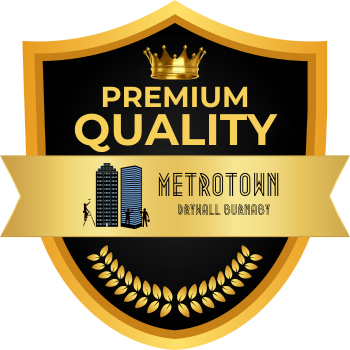Mold Remediation and Drywall Replacement Services in Burnaby, BC
Protect your home and family with professional mold remediation and drywall replacement services from Metrotown Drywall Burnaby. Our certified restoration specialists handle everything from black mold removal to water-damaged drywall replacement, ensuring your Burnaby property is safe, healthy, and structurally sound.
With Burnaby’s damp coastal climate creating ideal conditions for mold growth, our experts use advanced containment, drying, and sanitation techniques to eliminate mold at its source. We replace contaminated drywall with mold-resistant materials, restoring your walls and ceilings to their original condition while preventing future damage.
Call (604)-330-8736 today to schedule your mold inspection and drywall restoration service in Burnaby, BC — and trust Metrotown Drywall Burnaby for proven, professional water damage repair and mold prevention solutions.


Mold Remediation Services in Burnaby, BC
Mold remediation services in Burnaby address critical health and structural concerns through comprehensive inspection, targeted removal processes, and specialized repair of water-damaged areas. Professional teams handle everything from initial assessment to complete restoration of affected spaces.
Professional Mold Inspection and Assessment
Professional mold inspection forms the foundation of effective remediation in Burnaby properties. Certified inspectors use moisture meters, thermal imaging cameras, and air quality testing equipment to identify hidden mold growth behind walls and in crawl spaces.
The assessment process includes visual examination of common problem areas like basements, bathrooms, and areas with previous water damage. Inspectors take air samples to determine mold spore concentrations and identify specific mold types present in your property.
Key inspection areas include:
- Behind drywall and insulation
- HVAC systems and ductwork
- Crawl spaces and attics
- Areas around plumbing fixtures
Laboratory analysis of collected samples provides detailed information about mold species and contamination levels. This data guides the remediation strategy and helps determine the scope of drywall replacement needed.
Documentation includes moisture readings, photographs, and detailed reports outlining affected areas. These assessments ensure targeted treatment and help prevent future mold infestation.
Black Mold Cleanup and Removal Process
Black mold cleanup requires specialized containment procedures to prevent spore distribution throughout your Burnaby home. Professional teams establish negative air pressure systems and seal affected areas with plastic sheeting before beginning removal.
The mold removal process involves treating colonies with antifungal and antimicrobial solutions. Heavily contaminated porous materials like drywall, insulation, and carpeting require complete removal and disposal following safety protocols.
Standard removal steps include:
- Containment setup with air filtration
- Personal protective equipment for workers
- Careful removal of contaminated materials
- HEPA vacuuming of all surfaces
- Application of antimicrobial treatments
Workers wear full protective suits and respirators during the mold removal services. All contaminated materials are bagged and disposed of according to local regulations.
Air scrubbers with HEPA filters run continuously during the process to capture airborne spores. Post-remediation testing confirms successful mold elimination before containment removal.
Ceiling Mold and Moisture Damage Repair
Ceiling mold repair addresses common issues caused by roof leaks, plumbing problems, and poor ventilation in Burnaby homes. Moisture damage creates ideal conditions for mold growth in ceiling materials and insulation.
Professional teams remove water-damaged drywall sections and treat underlying structural elements. Moisture sources must be eliminated before installing new materials to prevent recurring mold infestation.
The repair process includes removing stained or sagging ceiling sections and replacing damaged insulation. New drywall installation follows proper moisture barriers and ventilation requirements.
Repair components involve:
- Source moisture elimination
- Structural drying and treatment
- Insulation replacement
- New drywall installation and finishing
Proper ventilation installation prevents future moisture accumulation. Exhaust fans in bathrooms and kitchens help maintain appropriate humidity levels.
Matching existing ceiling textures and paint finishes restores the appearance of repaired areas. Quality materials resist future moisture damage and mold development.
Health Impact of Mold Infestation
Mold infestation significantly impacts indoor air quality and poses serious health risks to Burnaby residents. Exposure to mold spores triggers allergies, respiratory problems, and other health complications, particularly in sensitive individuals.
Common health symptoms include persistent coughing, sneezing, throat irritation, and skin reactions. People with asthma or compromised immune systems face increased risks from mold exposure.
Health effects may include:
- Respiratory irritation and infections
- Allergic reactions and skin problems
- Headaches and fatigue
- Worsening of existing conditions
Long-term exposure to certain mold types can cause more severe health problems. Black mold produces mycotoxins that may lead to neurological symptoms and immune system suppression.
Children and elderly individuals show heightened sensitivity to mold exposure. Prompt mold remediation services protect family health and prevent symptom escalation.
Indoor air quality testing confirms successful remediation and safe living conditions. Professional treatment eliminates health hazards and restores clean air quality in your home.
Comprehensive Drywall Replacement and Restoration
Professional drywall replacement and restoration addresses structural damage from water intrusion and mold contamination through systematic removal, treatment, and reinstallation processes. These services require specialized techniques for safe material handling and complete surface restoration.
Water-Damaged Drywall Repair Solutions
Water-damaged drywall requires immediate assessment to determine repair versus replacement needs. Professional drywall services evaluate moisture penetration depth and structural integrity before proceeding.
Assessment Process:
- Moisture meter readings to detect hidden saturation
- Visual inspection for warping, discoloration, or soft spots
- Structural evaluation of underlying framing
Minor water damage affecting only surface layers can be repaired through targeted drying and refinishing. Extensive saturation requires complete drywall removal and replacement.
Professional contractors use industrial dehumidifiers and air movers for thorough drying. This prevents secondary mold growth during the restoration process.
Repair Methods:
- Surface repairs: Sanding, priming, and refinishing
- Partial replacement: Cutting out damaged sections
- Complete replacement: Full panel removal and installation
Drywall Restoration for Mold-Affected Walls
Mold-contaminated drywall demands specialized removal and disposal procedures to prevent spore dispersal. Professional drywall services follow containment protocols during restoration work.
Containment barriers isolate affected areas using plastic sheeting and negative air pressure systems. Workers wear protective equipment including respirators and disposable coveralls.
Restoration Steps:
- Containment setup - Seal work area with plastic barriers
- Material removal - Cut drywall beyond visible contamination
- Surface treatment - Clean underlying framing with antimicrobial solutions
- Moisture control - Address source of water intrusion
Mold-resistant drywall installation follows removal and treatment. These specialized panels contain fiberglass facing that resists moisture absorption and mold growth.
New drywall installation includes proper vapor barriers and ventilation considerations. This prevents future moisture problems in restored areas.
Drywall Removal and Safe Disposal
Professional drywall removal follows systematic procedures to minimize dust and debris spread. Proper disposal methods comply with local waste management regulations.
Removal Techniques:
- Score cutting along stud lines for clean breaks
- Remove fasteners completely to avoid protrusion
- Work in manageable sections to control debris
Contaminated materials require special handling and disposal at approved facilities. Regular drywall can be recycled at construction waste centers.
Workspace preparation includes floor protection and debris collection systems. Professional contractors use HEPA vacuums for dust control during removal.
Post-removal cleaning eliminates remaining debris and prepares surfaces for new drywall installation. This includes stud cleaning and inspection for underlying damage.
Drywall Repair, Reinstallation, and Finishing
Professional drywall repair requires precise installation techniques, advanced sanding methods, and comprehensive restoration approaches. These processes ensure seamless integration with existing surfaces while maintaining structural integrity and aesthetic appeal.
Precise Drywall Reinstallation Steps
Your drywall reinstallation begins with accurate measurements and proper material selection. Cut replacement panels to exact dimensions, leaving minimal gaps at joints.
Secure drywall sheets using appropriate fasteners spaced 16 inches apart along studs. Drive screws slightly below the surface without breaking the paper face.
Apply moisture-resistant drywall in areas prone to water exposure. This prevents future mold growth and extends the lifespan of your repairs.
Joint compound application follows a three-coat system:
- First coat: Embed tape and fill screw holes
- Second coat: Smooth and widen joints
- Third coat: Feather edges for seamless blending
Allow 24 hours drying time between coats. Proper curing prevents cracking and ensures durable adhesion.
Drywall Sanding and Refinishing Techniques
Sand dried joint compound using 120-grit sandpaper for initial smoothing. Progress to 220-grit for final finishing to eliminate visible ridges.
Use sanding blocks for flat surfaces and flexible sanding sponges for corners. Maintain consistent pressure to avoid creating depressions in the compound.
Dust removal is critical before painting or texturing. Vacuum thoroughly and wipe surfaces with a damp cloth.
Apply primer to all repaired areas before final coating. This ensures uniform paint absorption and prevents flashing between old and new surfaces.
For textured walls, match existing patterns using spray textures or hand-applied techniques. Practice on scrap material first to achieve consistent results.
Interior Wall and Ceiling Restoration
Ceiling repairs require specialized support techniques during installation. Use temporary braces to hold panels while fastening to prevent sagging.
Address water-damaged areas by replacing affected insulation and treating structural elements. Check for moisture damage extending beyond visible staining.
Restore original wall textures using these common methods:
Texture Type Application Method Tools Required
Orange Peel Spray gun Compressor, hopper
Knockdown Trowel smoothing Spray gun, knife
Popcorn Acoustic spray Specialized equipment
Prime all restored surfaces with high-quality primer suitable for your specific wall covering. This step prevents previous stains from bleeding through new finishes.
Match paint sheens to existing surfaces for uniform appearance. Use the same paint brand and formula when possible to ensure color consistency.
Mold Prevention and Residential Solutions
Effective mold prevention requires consistent moisture management and professional intervention when issues arise. Burnaby residents benefit from comprehensive strategies that address both immediate concerns and long-term protection.
Ongoing Moisture Control and Monitoring
Maintaining optimal humidity levels between 30-50% prevents mold growth in your home. You should monitor moisture levels using digital hygrometers and address any readings above this range immediately.
Critical Areas to Monitor:
- Basements and crawl spaces
- Bathrooms and laundry rooms
- Kitchen areas near sinks
- Around windows and doors
Regular mold inspection helps identify problem areas before they become serious health hazards. You need to check for water stains, musty odors, and visible discoloration on walls and ceilings monthly.
Proper ventilation removes excess moisture from daily activities. Install exhaust fans in bathrooms and kitchens, and ensure your HVAC system circulates air effectively throughout your Burnaby home.
Address water leaks within 24-48 hours to prevent mold establishment. Even minor plumbing issues or roof leaks can create conditions for extensive mold growth behind drywall surfaces.
Residential Mold Remediation Programs
Professional mold remediation protects your family from health risks including allergies and respiratory issues. Certified technicians assess contamination levels and develop targeted treatment plans for your specific situation.
Remediation Process Steps:
- Initial Assessment - Identifying contaminated areas
- Containment - Preventing spore spread
- Removal - Eliminating affected materials
- Cleaning - Sanitizing surfaces and air
- Restoration - Replacing damaged drywall
You should contact professionals when mold covers areas larger than 10 square feet or affects HVAC systems. Black mold cleanup requires specialized equipment and safety protocols that protect occupants during removal.
Air quality testing before and after treatment ensures complete remediation. This verification process confirms that spore levels have returned to normal ranges and your home environment is safe.
Choosing Drywall Contractors in Burnaby BC
Licensed drywall contractors provide expertise in both mold remediation and structural restoration. You need professionals who understand moisture damage patterns and proper installation techniques for lasting results.
Contractor Qualifications:
- Certification - Mold remediation credentials
- Insurance - Liability and workers' compensation
- Experience - Local Burnaby project history
- References - Verified customer testimonials
Professional drywall services include moisture damage assessment, material removal, and complete reinstallation with mold-resistant products. These contractors coordinate with remediation specialists to ensure comprehensive treatment.
Metrotown Drywall Burnaby offers integrated solutions that address both mold issues and structural repairs. Contact (604)-330-8736 to schedule an evaluation of your drywall restoration needs and develop a prevention strategy for your property.